The document discusses multi-channel MAC protocols in cognitive radio networks, highlighting three primary approaches: common control channel, split phase, and common hopping. It explains the concept of cognitive radio, which aims to utilize unused spectrum without disrupting primary users while detailing several existing cognitive MAC protocols. The summaries of protocols like Hang Su and Xi Zhang's MAC protocol, HC-MAC, and Noun Choi et al.'s MAC protocol illustrate their unique characteristics and operational procedures.
























